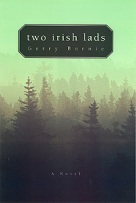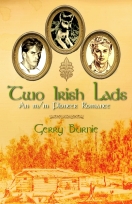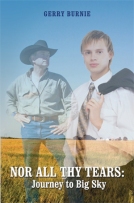| I have long maintained that the most interesting history of any nation is not found in its celebrities, but in the antics of its most colourful characters. Madame Bendixen is not a name that comes readily to mind, but she was certainly colourful.
If you know of any similar characters, don’t hesitate to send me a clue. Leave a comment, or email me, at: gerrybbooks@yahoo.ca. I’d love to hear from you. |

M. Bendixen and his stout wife erected the modest two-storey brick hotel, on the present site of the Eaton’s Centre, upon their arrival in the Crown Colony of Vancouver Island in 1862. For a while the St. George was Victoria’s finest, its “accommodating” host and hostess enjoying a profitable business.
That is, when the madame wasn’t “in one of her queer moods”.
For Mrs. Bendixen, it would appear, was as fiery and loud as she was stout, and not many ventured within range when she was on the warpath. When the town experienced hard times, the landlady’s notorious disposition became even worse, driving what few clients remained to seek other accommodations.
They’d have scarcely believed that, just eight years before, she’d been “one of the handsomest and daintiest of the smart set of San Francisco”. Many times, hundreds of admiring eyes had followed the beautiful woman in the shining carriage drawn by a magnificent team of horses along Montgomery Street. The mistress of a leading Bay City underworld figure, she enjoyed a life of royalty, with the finest of jewels, furs and silks.
Then, unaccountably, she changed almost overnight. Instead of the haughty paramour she became a tower of virtue, even announcing her forthcoming marriage. Retiring to a cottage, she attended church and shunned all association with her former cronies.
Her rejected lover reacted with gifts and kind words then threats. The police, riddled by corruption, turned a deaf ear to her pleas for protection. She refused to yield even when nitric acid was splashed across her gown. After two thugs beat her fiancé unmercifully and she miraculously survived the bombing of her cottage, she had endure “the most scandalous stories” that were spread about her.
Rather than break her spirit, wrote pioneer Victoria journalist D.W. Higgins, who’d known her slightly while in living in California, the terror campaign “only increased her religious fervour and tended to confirm her in a desire to reform”. When next he’d seen her, in Victoria, instead of the “shrinking, timid, handsome girl of several years before, she had developed into a fat, bold and quarrelsome, middle-aged woman”. So dramatic was the change in Madame Bendixen’s appearance that Higgins hadn’t recognized her at first.
For four years, Louis and Fanny Bendixen, who’d invested their savings in the St. George, struggled to keep it afloat. But Victoria was in a recession; businesses foundered and thistles grew in the dusty intersections of Yates and Government streets, the city’s busiest thoroughfares.
Finally, they sold, no doubt, at a loss. By this time, not even Louis could stand his wife’s shrewish tongue and he left for California, she moving to the Cariboo to open a modest saloon in Barkerville. Years later, word reached Victoria of her death at the age of 70.
She’d admitted to being 44.
Which brings us to a 1996 column in the Times-Colonist in which the late writer/historian Charles Lillard pondered Madame Bendixen’s real story. He’d read Higgins, of course, but what intrigued him most were fleeting references to Mrs. B in W.B. Cheadle’s classic Journal of a Trip Across Canada. Written 20 years after he and Viscount Milton made most history as being among B.C.’s first tourist explorers, Cheadle described their stay in Victoria in 1864, the leading citizens they met socially while staying at the St. George where, in stark contrast to her previously described notoriety and foul temper, they were “rapturously welcomed” by their hostess. At a dinner at the Thomas Harris home, Mrs. Bendixen “inveighed against the degradation of dining with le gros boucher,” their host and the city’s first mayor having made his fortune as a butcher.
In his book, Cheadle describes other dinners, others of the city’s and colony’s leading citizens, among them Gov. and Mrs. James Douglas and (so-called) Hanging Judge Matthew Begbie. Lillard found the references to the mysterious Mrs. B to be the most intriguing and glumly conceded, “I still don’t know the [real] identity of Mrs. Bendixen.”
In Barkerville, Richard Thomas Wright devotes two pages to “the enigmatic” Fanny ‘Bendixon’ who arrived in Barkerville aged about 25, to become owner, over the years, of several saloons (among them, shades of Victoria, the St. George) and, quite likely, a brothel keeper. By then she was thought to weigh in excess of 300 pounds, so large that she straddled two chairs while dispensing drinks to patrons, and prompting Judge Begbie to refer to her in a letter as being of “undiscoverable girth although she was always of goodly diameter”.
By then she was known, particularly to children, for her genial disposition although her fiery temper lurked, as always, just beneath the surface and required little to spark an eruption of profanity. Her death, in January 1899, prompted a civil suit over disposition of her valuable earrings.
We’ll leave the last word on this mystery woman to Richard Wright: “Even in death Fanny Bendixon was a woman who captured the imagination of many and likely the hearts of many a miner and businessman along the creeks.”

















